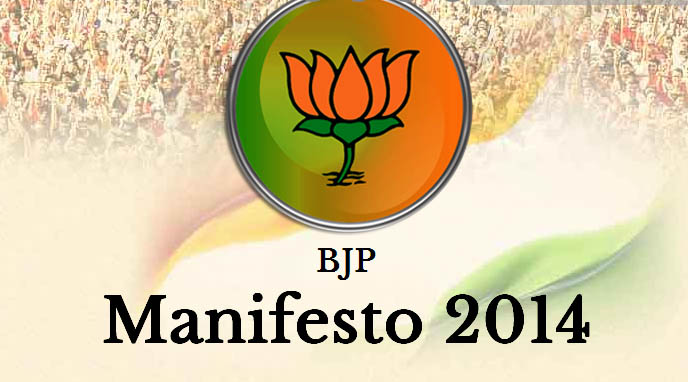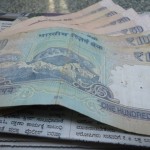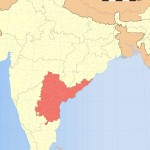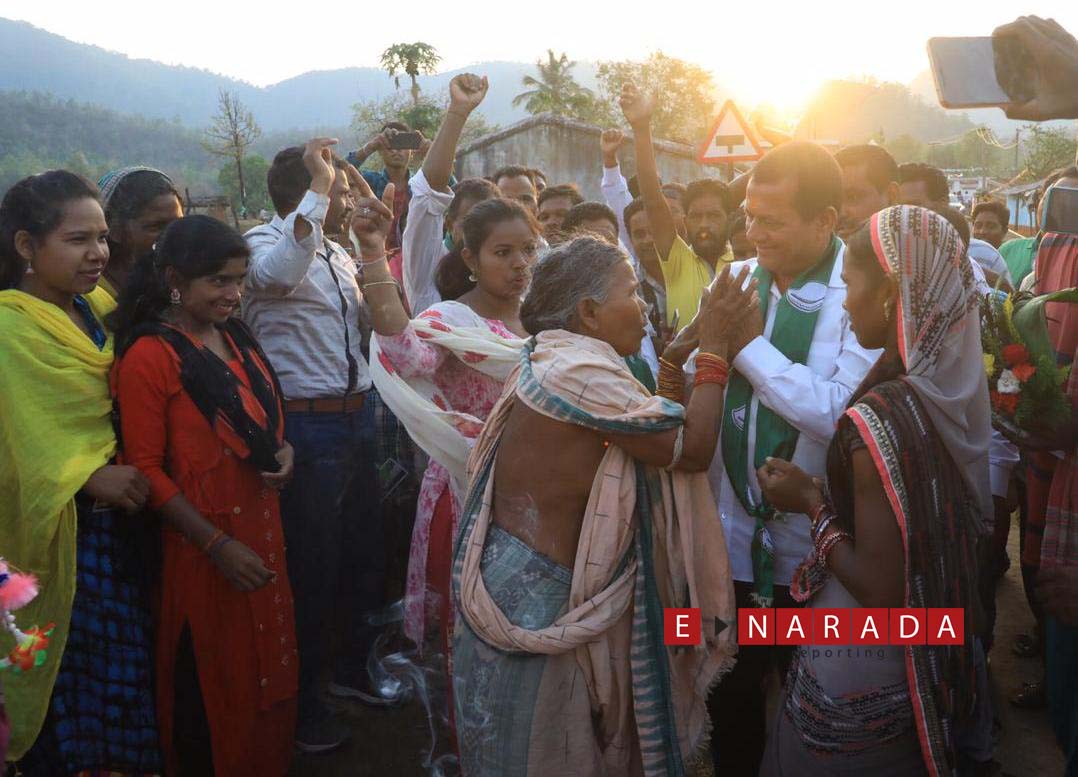ENARADA, New Delhi
By AJAY N JHA
Elections in India are a peculiar phenomenon. Politicians of all ilk, faith and region suddenly descend on the poll scene to cover the electoral ground like a swarm of locusts and devour voter’s mandate. They promise a full-moon in the afternoon and even promise to build a bridge on a river which actually does not exist.
One of their weapons to please and plead with their voters with all kinds of promises and plethora of goodies is their magnum opus called “manifesto of their party” which tries to touch upon every problem faced by a voter from top to toe and that wonderful document called “manifesto” works as a panacea- as incredible and wondrous instrument which is capable of putting a giraffe in a small glass.
However, the tone and tenor of that document has changed considerably over the years. The Congress party has by and large, still been a hostage to Gandhi -Nehruvian philosophy and outlook on so many issues which may not be as relevant as it was perhaps two decades ago. Yet that is the tagline because even today, a large number of Congress leaders and workers believe that the Congress party manifestos and Nehru and Gandhi name would be seen as a bundle of trash and would not be able to attract the voters attention.
The BJP, on the other hand, has been laboring hard over the years to look different and think different, at least in certain areas like economy and foreign policy but without much success. That could be seen from the fact that the 1977 Manifesto of Janata Pariwar was almost the same as that of Pandit Nehru even as the then Minister for External Affairs Atal behari Vajpayee learnt this hard way at Jawaharlal University campus when a batch of young students literally cornered him for his utterances.
The BJP has come a long way since then and its 6 years rule at the Cente during 1998-2004 gave it the will and determination to do a few things differently. However, it was the Election slogan that did the trick more than the bulky Manifesto. In 2004, the slogan Congress ka Haath—AAM AADMI (Mango Man) KE SAATH won over the scintillating and exorbitantly hyped “India Shining” campaign of the BJP which flopped miserably. In 2009, the Telugu Desam promised everything from free houses to unemployment incomes to Andhra voters, but YSR trounced him. YSR even managed to beat back the Telangana wave by promising Telangana during phase one of the voting and then reneging on it in the Seemandhra phase.
The election of 2009 more or less followed the same pattern even as regional political parties followed an entirely different set of agendas where local issues took the cake and the rest appeared either hazy of fake.
This time Congress Vice- President Rahul Gandhi has promised even more rights and entitlements – from health to houses to even entrepreneurship – but the polls have not registered any impact as yet.
However, it is the advent of new media and social media which has totally transformed the election scenario. Information is reaching faster like lighting and the younger generation does not have the patience to browse through all these papers which could be explained to them in a few words or sentences. The power of proper slogan as seen in recent American elections like “Change we want” and yes, we can, seems to have metamorphosed the whole set of poll gimmick and the means of delivery mechanism.
Lok Sabha polls of 2014 is going to be far quicker, straight, curt and dry that way. But the BJP has become a butt of joke here as well. The tug of war between the elders and the Modi brigade within the BJP has prolonged the misery of the party and dented its image as well. The metamorphosis from Murlifesto to Modifesto apparently has taken more than a month. In the process, the BJP, the frontrunner in this election, may not be able to release its manifesto – originally drafted by Murli Manohar Joshi and now being extensively rewritten by Editor Narendra Modi – before the elections actually kick off on 7 April.
More than the timing and intent, this phenomenon appears to have sparked off a fierce debate in many political and academic circles if Manifestos really matter and if they really influence voters mind in a big way? More than that, do they make a difference to the outcome? Are the promises made in manifestoes worth the paper they are printed on?
If that was the case, then how’s that the Congress party’s all-things-to-all people manifesto did not making any difference to the AAM AADMI’s voting intent in last Assembly elections.
The truth is that manifestoes are too complex to make a difference because what voters look for are simple messages that they can digest. A simple freebie or slogan (Rice at Rs 2, Garibi Hatao) is far easier to understand than a 60-page document that promises everything from a lower fiscal deficit to women’s empowerment to a broadband revolution.
While most the politicians still tend to treat their voters as their pocket boroughs and go to the extent of taking them for granted as well, the reality that today’s voters are not fools. They know that all governments promise the moon and end up offering a mere reflection of it in the voter’s bowl. So the one credible promise will always work better than a platter of pies-in-the-sky. This is not to say manifestoes do not matter at all, but to be believed, they must be credible. One of the reasons why Modi is supposed to have delayed the “Modifesto” is that the “Murlifesto” made too many promises while Modi wants to keep it simple and straight.
Perhaps team Modi does not want to follow the same pattern as Congress which has spent 10 years in office, had just rattled those achievement and very little on future promises. So, at least in the Congress case, the manifesto matters less than its track record.
On the other hand, Modi has been behaving like a walking manifesto. He has painted a vision of growth, sold the Gujarat model, jobs and change even while demolishing the Congress’ alleged non-performance. He has been issuing his manifesto in instalments – starting with the Vision statement in January (infrastructure, 100 new cities), and following it up by a speech to business in February and then taking it to another pitch by talking about defence and foreign policy and so on.
During last 40 years, almost every Lok Sabha election had revolved around a central theme. It started with Indira Gandhi’s Garibi Hatao in 1971 and has come a long way since then. This time around, the Congress has tried to weave a theme around secularism and fear of Modi, while the latter is laboring hard to paint himself as the development messiah. These two themes are already driving the message from both sides, and this time it seems the combo is working for Modi better than the Congress. Development is working for Modi, while communalism could result in some kind of mild reverse polarisation of the majority community, which again could benefit him. In this scenario, a manifesto with 100 disparate themes to woo different parts of the electorate will only clutter the voter’s mind. There is no need to confuse when clarity is already there on both sides.
Perhaps, team Modi is careful this time not to fall in the same rut because “Manifestoes can be constricting. Manifestoes are a crutch when you have nothing else to tell the electorate; they are a tripwire for a party that hopes to win and form a government. A party that wants flexibility in policy-making after it is elected cannot tie itself to a promise it cannot keep” says a veteran commentator.
The tragedy for the BJP has been that for the last 20 years, it has not been able to get the Ram Temple business off its manifesto. Now, if it emphasizes the same, then the minorities will be upset. If it removes the temple from the manifesto, it upsets the core base. A skimpy manifesto that serves up broad principles and one or two big specific promises is more workable than a document festooned with unbelievable offerings. Modi’s big advantage is that the electorate this time is not looking for big promises. It is looking for governance – especially after the complete failure of the UPA’s diarchy to deliver in the last five years.
That is why Modi appears to have made the whole party campaign around himself than the BJP. By being himself and positioning himself as the guy who gets things done, Modi is selling the idea that he will solve their problems, whatever they are and that is why he does not quite need a Manifesto.
But then, this is a double-edged weapon which could cut and slash both ways. On the positive side, it gives Modi a direct connect with his voters while on the negative side, it could be termed as his over-arrogance and cockiness. How the voters of India react would be clear only after 16th of May. Till then, the macabre dance of democracy would go on as usual.
(Posted on April 6, 2014 @ 9:45 pm)
(Ajay N Jha is a veteran journalist from both Print and Electronic media. He is Advisor to Prasar Bharti. The views expressed are his personal. His email id is Ajay N Jha <ajayjha30@gmail.com> )
The views expressed on the website are those of the Columnists/ Authors/Journalists / Correspondents and do not necessarily reflect the views of ENARADA.











Bribing The Voters
Retired Chief Election Commissioner , S Y Quraishi , is all set to release his book ,
” The Undocumented Wonder : The Making of the Great Indian Election ”
Talking to DNA ( 15 April 2014 ) he listed some 40 different ways in which , Political Parties try to bribe voters
Some of these are :
> Cash
> Depositing money in voter’s bank account
> Liquor Bottles
> LPG Cylinders
> Free Rice / Food Packets
> Payments of Electricity / Water Bills
> Mass Feasts
> Screening of films
> Laptops / Tablets
> Bicycles
> Mangal Sutras
> Gold Coins
> Buffalos
> Colour TV
> Mixer – Grinder
> Unemployment Allowance
> Waiver of loans
> Free Houses ……etc
Political Parties are happy that Mr Quarishi , being an honest / straight forward person , could imagine only 10 % of the ways of bribing voters !
And who cares that the EC has managed to seize a meager Rs 300 crores worth of cash so far during the current season , when all of the Rs 40,000 Crores worth of black money ( @ Rs 5 crores per candidate * 8,000 candidates ) , has escaped un-noticed ( looking other way ? ) by ,
> Income Tax Department
> Enforcement Directorate
> CAG / CVC
> Election Commission…..etc
Even the almighty Supreme Court seemed helpless , when it held recently :
” Although promises of distribution of freebies may not technically constitute corrupt practice , under the Representation of People Act , they vitiate the electoral process by influencing voters and disturbing the level playing between contesting parties ”
And since there is no difference of opinion between the political parties when it comes to exploiting the poverty of 400 million BPL ( Below the Poverty Line ) voters , I would not be surprised if the next government at the Centre , introduces a ,
” Bribe ( given ) Politically ( is ) Legal Bill ” ( for BPL people ! )
in the very first session of 16th Lok Sabha !
Expect it to be passed unanimously – and without a debate !
Political parties are firm believer of what Kaushik Basu ( onetime advisor to PM ) once said ( – although in a different context ) ,
” Giving bribe must not be treated as crime
Ordinary citizens are forced to give bribes when they are denied , service that is legitimately due to them
If they are held innocent , they will come forward and report all instances when they were forced to bribe bureaucrats
Only bribe-takers must be punished ”
* hemen parekh ( 28 April 2014 / Mumbai )